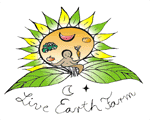
~~~~~~~~~~~~~~~~~~~~~~~~~~~~~~~~~~~~~~~~~~~
Live Earth Farm (Com)Post
4th Harvest Week, Season 13
April 28th - May 4th, 2008
~~~~~~~~~~~~~~~~~~~~~~~~~~~~~~~~~~~~~~~~~~~
In this issue
--Greetings from Farmer Tom
--What's Up in the Field
--Shakespeare on the Farm!
--Mataganza Garden Sanctuary takes on Medicinal Herb
Production
--Plenty of Eggs this year
--Pictures around the farm
--What's in the box this week
--Notes from Debbie's Kitchen
--Calendar of Events
--Contact Information
" A fundamental human right is the right to pleasure,
a natural physiological right, the denial of which has contributed greatly
to the present global situation. "
~
Carlos Petrini, from 'Slow Food Nation'
Greetings from Farmer Tom
~~~~~~~~~~~~~~~~~~~~~~~~~~~~~~~~~~~~~~~~~~~~~~~~
Who says you have to live in the countryside to start a self-sufficient life-style? On the front page, no less, of last Tuesday's Wall Street Journal, amidst its mostly mind-numbing financial news, was an article about front yard mini-farms. If the Wall Street Journal (considered to be the daily financial horoscope for investors around the world) runs a front-page article on a subject such as self-sufficient gardening, is this an indicator that the wheelbarrow may be replacing the mighty shopping cart? Folks with a more pessimistic perspective might interpret the message as we’re on the verge of another Great Depression. The last time victory gardens were in fashion and people grew their own food was during World War II.
It’ll be awhile yet before lawns, the trademark of American suburbia, come under siege and homeowners recognize their value as a potential resource for growing food. Over 80% of US households have lawns, which adds up to a whopping 30-40 million acres of land – something like the size of Kentucky and Florida combined. Americans spend an average 40 billion dollars annually on their lawns, applying over 70 million tons of pesticides and fertilizer – about 10 times more than the average farm applies per acre. Most yards today serve as a status symbol. The greener the lawns and bigger the dahlias the more attractive the home (and often the more valuable when appraised). A compost pile and thriving vegetable and fruit garden in the front yard is not (at least not yet) considered a valuable landscape feature in most urban and suburban neighborhoods.
Not long ago our ancestors really did garden for self-sufficiency; it wasn't an option, it was a way of life. My mother still tells me stories how in her family money wasn't used for things you could grow or make yourself, but only for tools, clothes, or sometimes luxury items such as coffee and chocolate. This may sound a bit radical, but imagine if CSA members grew food in their own gardens and then sold or contributed a portion of their production to fellow CSA members. From Debbie's point of view this would probably be the ultimate logistical nightmare. But it's conceivable to see neighborhood pick-up sites becoming outlets for productive local neighborhood gardens.
It was exactly a year ago that Debbie's husband Ken launched an interactive game on the web called World Without Oil, which opened with the ‘alternate reality’ that gasoline had hit $4 a gallon. In real life, less than a year later, we are already paying over $4 a gallon for diesel fuel to operate our farm machinery. The future of an abundant and healthy food supply is going to depend increasingly on local and regional food belts, where consumers develop direct relationships with food producers. I like Slow Food’s concept of consumers (or eaters, to be more precise) being “co-producers”, i.e. intimate participants in the food growing process. Being a Community Supported Farm we are well on our way to building our network of food producers and co-producers.
Finding energy-efficient strategies for growing and delivering crops to you, our ‘co-producers’, is becoming increasingly important. From my point of view, I am looking for ways to become more efficient in how we package and distribute our shares; I am also looking into ways to reduce the cost of outside inputs by increasing our own compost making capabilities. We were fortunate this winter to have seized an opportunity to acquire a piece of land adjacent to our farm, which in the long term will substantially cut our production costs since it will reduce the amount of time and transportation required to tend our fields (currently we grow crops on 5 different leased parcels, two only a mile or so away, but three, although still here in the Watsonville area, are much further). Having our own land also removes the uncertainty that comes with leased land.
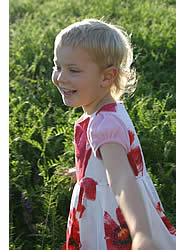 Our goal, as Carlos Petrini (founder of the Slow Food Movement) so well describes
in his book "Slow Food Nation", is that our food must meet three criteria:
quality, purity, and justice. We are what we eat, and we are all called upon
to evaluate how our food is produced, sold, and consumed. When I see Elisa play
in the fields, tasting and exploring the treasures this land sprouts forth, it
reminds me that the most important thing about food is that it is pleasurable.
When food meets Petrini's three criteria, it will inherently be more pleasurable
to consume. The pleasure of food serves as the primary reason why we should care
about a sustainable food system, which in turn contributes to a happier and healthier
future.
Our goal, as Carlos Petrini (founder of the Slow Food Movement) so well describes
in his book "Slow Food Nation", is that our food must meet three criteria:
quality, purity, and justice. We are what we eat, and we are all called upon
to evaluate how our food is produced, sold, and consumed. When I see Elisa play
in the fields, tasting and exploring the treasures this land sprouts forth, it
reminds me that the most important thing about food is that it is pleasurable.
When food meets Petrini's three criteria, it will inherently be more pleasurable
to consume. The pleasure of food serves as the primary reason why we should care
about a sustainable food system, which in turn contributes to a happier and healthier
future.- Tom
<back to top>
What's Up in the Field
~~~~~~~~~~~~~~~~~~~~~~~~~~~~~~~~~~~~~~~~~~~~~~~~
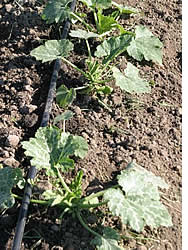 To my great relief, the peppers, eggplants and summer squash plantings I talked
about in last week’s newsletter dodged the ‘frost bullet’,
so if all goes well we should have a bumper crop. The tomato seedlings got planted
out last week... leeks are coming (probably will see them in next week’s
shares). Debbie or I will talk about how to differentiate them from green garlic.
Our next planting of carrots is coming along nicely, but it will be a few weeks
before we have them in the shares again. Anticipation hones the taste buds! And
of course the strawberries are really starting to produce. Just in time for the
Extra Fruit option, which starts next week...
To my great relief, the peppers, eggplants and summer squash plantings I talked
about in last week’s newsletter dodged the ‘frost bullet’,
so if all goes well we should have a bumper crop. The tomato seedlings got planted
out last week... leeks are coming (probably will see them in next week’s
shares). Debbie or I will talk about how to differentiate them from green garlic.
Our next planting of carrots is coming along nicely, but it will be a few weeks
before we have them in the shares again. Anticipation hones the taste buds! And
of course the strawberries are really starting to produce. Just in time for the
Extra Fruit option, which starts next week...
(at left, healthy summer squash seedlings)
<back to top>
Shakespeare on the farm!
~~~~~~~~~~~~~~~~~~~~~~~~~~~~~~~~~~~~~~~~~~~~~~~~
Please join us for the Wavecrest Montessori Production of William Shakespeare’s
A Midsummer Night’s Dream – right here on the farm!
Santa Cruz Montessori Wavecrest Middle School invites the Live Earth Farm community
to enjoy their production of A Midsummer Night’s Dream among the stars
and apple trees:
7p.m. this Thursday May 1st and Friday May 2nd
Click here for
directions to the farm. The play will be held out in the fire
circle, where we hold our community celebrations.
<back to top>
Mataganza Garden Sanctuary takes on Medicinal
Herb Production
~~~~~~~~~~~~~~~~~~~~~~~~~~~~~~~~~~~~~~~~~~~~~~~~
Greetings to friends of the farm, old and new... I wanted to give a seasonal
update on what’s going on in our Permaculture demonstration site and retreat
space, known at the farm as Mataganza, and invite all of this year’s new
CSA members to participate in some of our educational programs and community
events. The Mataganza Garden Sanctuary is a one-acre garden and retreat
space at Live Earth Farm dedicated to the discovery, application, and celebration
of the dynamics of Nature. Over the past several years it has been a laboratory
for many CSA members, students and members of the community at large to learn
about Permaculture, get hands-on gardening experience and reflect on the role
of humanity in the natural world. In the upcoming months we will host a
gardening internship program, several workshops on Permaculture and Herbalism,
and celebrate with a garden open house and work day. Please see the farm
calendar and website for dates and details. Mataganza is also home to a
free, public ceremony of Temple Guaracy, a group that practices the Afro-Brazilian
nature-based philosophy and spiritual tradition of Umbanda.
The Garden’s focus on medicinal species is beginning to crystallize this
season in a collaborative project with Five Flavors Herbal Pharmacy and the American
School of Herbalism. Ben Zappin and Ingrid Bauer who run this local business
and school will be making tinctures and other products from the wealth of herbs
that grow in the garden and are currently in propagation. In addition they
have already begun to teach public workshops on various aspects of herbalism – coming
up next is Herbal Medicine Making on May 10th and 11th. Also, stay tuned
for postings in the newsletter on the medicinal properties of some of the culinary
herbs included in the CSA shares that Ben and Ingrid will write throughout that
year. We look forward to sharing with you in this small but growing component
of the Live Earth Farm.
See You in the Garden,
Brian Barth, Caretaker of Mataganza
<back to top>
Plenty of Eggs this year
~~~~~~~~~~~~~~~~~~~~~~~~~~~~~~~~~~~~~~~~~~~~~~~~
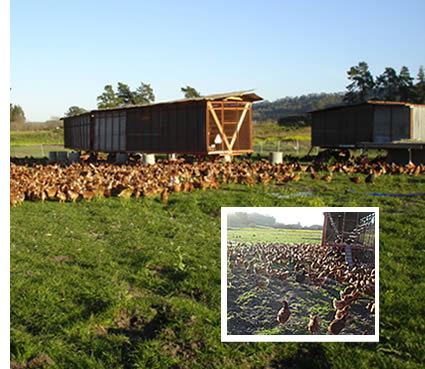 We still have Egg Options left, if you’re interested! Spring has sprung,
and Jim’s chickens are laying like nobody’s business. These eggs
are the Real McCoy: the hens spend their days outdoors on pasture where they
can run around, and eat green things and bugs in addition to their organic grain
mix. This makes for happy chickens, as well as nutritious eggs with rich, orange
yolks. These chickens get to keep their beaks too – a rare thing! Commercial ‘organic’ and ‘free
range’ chickens are regularly de-beaked shortly after hatching so they
don’t peck each other to death in close quarters. Jim’s birds are
not confined like that, so it is just not an issue.
We still have Egg Options left, if you’re interested! Spring has sprung,
and Jim’s chickens are laying like nobody’s business. These eggs
are the Real McCoy: the hens spend their days outdoors on pasture where they
can run around, and eat green things and bugs in addition to their organic grain
mix. This makes for happy chickens, as well as nutritious eggs with rich, orange
yolks. These chickens get to keep their beaks too – a rare thing! Commercial ‘organic’ and ‘free
range’ chickens are regularly de-beaked shortly after hatching so they
don’t peck each other to death in close quarters. Jim’s birds are
not confined like that, so it is just not an issue.
So if you were thinking about getting eggs but unsure if they were sold out,
take heart – they’re not! You can still get them! Email
Debbie at the farm with how many Options you’d like [1 Egg Option = ½ doz/wk],
and she’ll tell you the cost. (Cost is based on $3.25 per option per week,
so if you were to start next week, for example, the cost would be $94.25.)
<back to top>
Pictures around the farm
~~~~~~~~~~~~~~~~~~~~~~~~~~~~~~~~~~~~~~~~~~~~~~~~
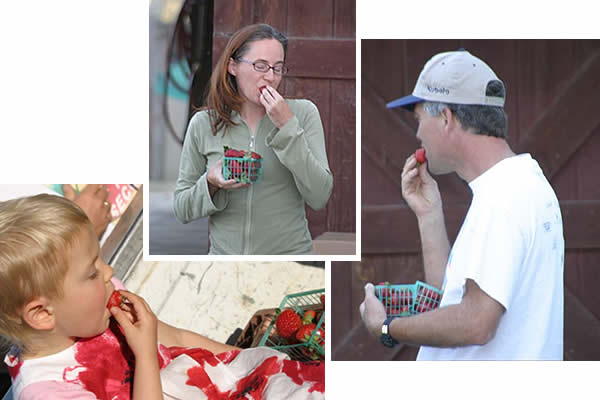
Elisa, Gillian (our new farm intern) and Tom take time out to savor
strawberries...
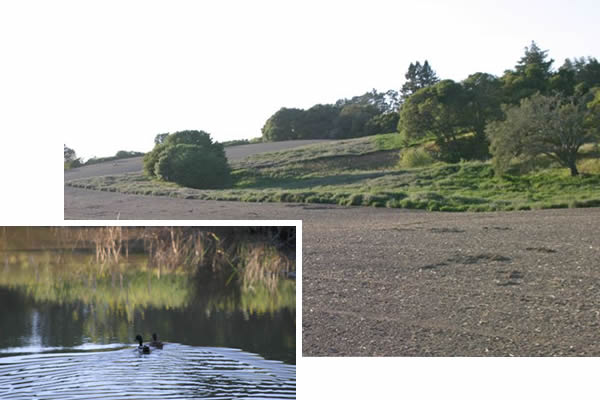
One view of some of Tom and Constance's new property; inset, ducks on
the pond which is at the back of the property. It is a truly beautiful
piece of land!
<back to top>
What's in the box this week
~~~~~~~~~~~~~~~~~~~~~~~~~~~~~~~~~~~~~~~~~~~~~~~~
Content differences between Family and Small
Shares are in red; items
with a “+” in
Family Shares are more in quantity than in Small; anticipated quantities, if
any, are in parentheses, as are the source of any produce if not from Live Earth
Farm (LEF).Occasionally content will differ
from this list (typically we will make a substitution), but we do our best to
give you an accurate projection.
Family Share:
Red beets +
Broccoli (Lakeside)
+
Chard
Fava
Beans +
Green
garlic
Red Russian Kale
Red leaf lettuce +
Onions +
Mustard
greens mix (mizuna and red
mustard)
Radishes
Strawberries (see binder at pickup site for quantities; probably 3 baskets)
Small Share:
Red beets
Bok choi
Broccoli (Lakeside)
Chard OR Kale
Fava
Beans
Green
garlic
Onions
Red leaf lettuce
Radishes
Strawberries (see binder at pickup site for quantities; probably 2 baskets)
Extra Fruit Option:
(starts next week!!)
<back to top>
Notes from Debbie's Kitchen
~~~~~~~~~~~~~~~~~~~~~~~~~~~~~~~~~~~~~~~~~~~~~~~~
Click
here to go to recipe database
Aaaah, the pleasure of food – now Tom’s talkin’ right up
my alley! There is so much joy in it; certainly in my life anyway! There’s
the fun of picking up the box each week (I like to ride my bicycle), seeing what
new goodies are in it. Even though the veggie list is in the newsletter ahead
of time, it’s just not the same as opening up the box and peering inside
to see all that vibrant freshness. And I really enjoy the ‘processing’ part
too – taking the time to prepare and store each item in such a way that
it will be good as new when I go to use it later in the week. Then there’s
the joy of cooking and preparing meals, the fun of looking at what you have and
creating something good to eat from it. When you have such fresh produce to work
with, it doesn’t require a lot of fancy preparation – the flavors
of the produce shine with simple preparation. And last but not least, the pleasure
of eating... well, that goes without saying!
Okay, enough yammering! ;-) I’m going to start by covering the new veggies
this week, and simple preparations for them. Depending on how much time I have
(these newsletters always take longer than I expect!) I’ll add some more
recipes at the end. - Debbie
Red beets, at long last!! We have been without them since late fall, when
Tom’s seed vendor sent him incorrectly labeled seeds, and so we had a huge
crop of white beets instead! All winter long, the only beets we got were white
ones, so I’m thrilled to have the color back. Tom says the greens from
this particular planting were not so presentable, so they will be topped in the
field as they’re harvested, and the leaves will be plowed back into the
soil with the next planting. (Normally I talk about cooking with beet greens
too, so I’ll hold off on that until we’re getting the green tops
along with the beets.)
Simple beet preparation: beets can be eaten raw or cooked. They can be cooked
many different ways too (roasted, baked, steamed, boiled), but a ‘quick-and-easy’ if
you’re new to them is to use a pressure cooker. A great reference for this
is a cookbook by Lorna J. Sass called “Cooking Under Pressure” which
has a whole section on ‘Vegetables A to Z’. In a nutshell, place
whole, unpeeled (easier to peel after cooking; see below) beets in a rack over
boiling water (2C to be safe; you don’t want the cooker to run out of water),
lock pot and bring to full pressure. Once pressurized, cook 10 to 15 minutes
(Lorna says 11-13 min for ‘small’, 3-4 oz. beets, and 20-22 min.
for ‘large’, 5-6 oz. beets), release pressure. Test beets for doneness:
they should pierce easily with the tip of a sharp knife. If they are still a
little firm, lock lid and cook for a few more minutes.
To peel cooked beets, first allow them to cool enough so you can handle them
(of course!) – sometimes when I’m in a hurry I’ll run them
under cold tap water a few seconds. Then cut off tops and tails, and you’ll
find that the skin just slips off! Very easy.
For your first taste test of a new veggie, I always encourage very simple preparation,
so you can see what the veggie tastes like before adding more elaborate flavors.
So take your cooked beets and cut them into wedges or slices, toss them while
still warm with a little butter so it melts, and then sprinkle with salt. Yum!
Also new this week are the mustard greens, although they’ll only
be in the Family Share this week (small shares will get their turn). I love the
mustard greens, especially the red mustard. I love using them as a salad green,
actually! (See below for using in salads.) First timers try this: take a fresh
leaf of red mustard, one that’s bright and alive, and pop it
in your mouth. Chew it slowly and thorouhly. Notice how at first, it’s
just kind of grassy... but then yowza! you get the flash of mustardy-heat that
it is named for. I love snacking on my leafy greens as I’m washing them.
My husband always manages to wander through the kitchen when I’m washing
greens so he can snack likewise.
Here’s an excerpt from a 2005 newsletter on how to wash and store them: “Key
rule: don’t stick wet veggies in a bag in the fridge; they’ll rot
quickly. You want humidity, but not wet. Place leafy greens in a sink or basin
of cold water and swish around gently but sufficiently to dislodge any dirt or
grit which will then sink to the bottom. Then remove them in small handfuls,
separating and tossing any excessively bruised or yellowed leaves (or the occasional
weed!) and place the washed greens in a salad spinner. Spin two or three times,
dumping the water after each spin (you want to get rid of that excess moisture!),
then spread the greens out on a cotton towel (or paper towels), layering if necessary,
and then roll up and store in a bag, gently squeezing the air out before sealing.
If you take the time to do this, I promise you will be glad you did come mid-week!
Fresh, washed, bagged greens? Piece o’ cake (and a joy!) to use.”
Using mustard greens in salads: Treat the peppery greens like you would
arugula; they’re good offset by fruity flavors – or even fruit, for
that matter! Try making a dressing with a sweeter vinegar such as balsamic, a
little dijon mustard, pinch of salt, and a mild or nutty oil (I like using roasted
walnut oil or flaxseed oil) and if you like, a squeeze of fresh lemon juice and
a dab of honey... toss greens with this then top with sliced strawberries! You
can embellish by adding chevre or feta cheese, and/or maybe a little bit of very
thinly-sliced onion. Toasted walnuts are nice too if you have ‘em but certainly
not required.
The favas are maturing nicely, so most of you are probably transitioning
to peeling off the pods and just using the beans within. (If you missed my discussion
on how to do this, see the Week
2 newsletter. Scroll down until you get to 'Fava Beans, continued')
Here is a recipe lovingly hand-written and mailed to me by member Carol Locke
last year. She has written me twice with info about this recipe actually, and
I have been saving them for the arrival of beets, as last year I became very
interested in fermenting foods. This is a compilation of both letters,
as she had different nuggets of info in each! [My comments in square brackets,
as per usual!]
Beet Kvass
Carol says, “Beet Kvass is a lactofermented product like kombucha or
kimchi or sauerkraut. In parts of the world where beets are a big crop, beet
kvass can take the place of vinegar in soups or dressings. Also it is an excellent
blood tonic, aid to digestion, etc. To get the health benefits of beets (raw
beets no less!) and those of a lacto-fermented beverage as well, I make beet
kvass and drink a 4 oz. glass morning and night. It has an unusual flavor but
quite pleasant and refreshing. If salt predominates, let it age in the refrigerator
until it develops a tangy acidity.”
3 medium-large organic beets, or equivalent smaller ones, peeled and coarsely
chopped. Do not grate beets for kvass as the small pieces exude too much juice
resulting in too rapid fermentation, favoring the production of alcohol rather
than lactic acid. [ ‘Course who knows? That may be interesting too!]
¼ C whey – obtained by dripping a good quality plain yogurt through
a coffee filter. The yogurt thickens and can be used for other things; save the
whey that drips out!
1 tbsp. sea salt [don’t use table salt, which has additives]
Place all ingredients in a 2 qt. glass mason jar [or similar], and add filtered
or distilled water to fill [tap water has chlorine which is counterproductive
to the fermentation process; don’t use tap!]. Stir well. Cover securely.
Keep at room temperature 2 days, then refrigerate. Pour off and use the liquid ‘kvass’. [I
keep my kvass at room temp for up to a week before refrigerating. If it develops
a 'bloom' of mold on the liquid's surface, that won't hurt anything: simply scoop
it off and discard. I find using a coffee filter for this works best: I carefully
slide it down one side of the jar mouth and under the mold, then slowly bring
it up under the other side. The kvass drains out and the mold stays on the filter.
Do this a couple times until you've removed the stuff to your satisfaction.]
When the liquid is gone, a second batch can be made by filling the container
again with filtered water and leaving at room temp. 2 days again, etc. After
that, discard [compost] the beets. You may want to use some of the liquid from
a former batch as a ‘starter’ for your next one, but it is not required. [I
also add more whey and salt with my second go-round.]
Additional notes from Debbie: the recipe can be easily doubled. I've
also used a mix of red and golden beets... and the kvass comes out mellower,
different. But delicious!
3/11/09 update: for further discussion on Beet Kvass, click
here (and
scroll to end of Winter Newsletter Week 8)
Beet Sandwiches
I missed this gem in Carol’s first letter – she talks about how “the
strong flavor of beets stands up to garlic very well. I like beets so well this
way [sliced cooked beets in a vinaigrette with lots of garlic] I seldom prepare
them any other way any more. They are good hot or cold, a great addition to salads,
but I also like them in sandwiches (!) with plenty of mayonnaise, lettuce,
salt and pepper!” So there you have it folks: beet sandwiches!
Roasted Broccoli with Lemon and Breadcrumbs
This is a variation on a recipe I ran in 2004; my friend and fellow member
Alie Victorine made this for me the other night and it was so easy and so delicious,
I had to run it again!
Broccoli cut into florets, stems peeled and cut into equivalent pieces
olive oil, salt and pepper for roasting
breadcrumbs
butter and olive oil
lemon zest
minced garlic [yes green garlic] or onion
juice from lemon [remember to zest it first!]
Toss broccoli with olive oil and sprinkle with salt and pepper. Roast in a hot
oven, about 425 degrees, for 20 minutes or so, until lightly browned.
In a small skillet or saucepan, melt butter and olive oil together. Add garlic
or onion and simmer a bit; add lemon zest and breadcrumbs and stir/cook until
they begin to crisp and brown. Remove from heat.
Put roasted broccoli in a bowl and squeeze lemon juice over all. Add prepared
breadcrumbs and toss together, then serve. Oh this is just so tasty!!
Variations:
<> You can steam the broccoli instead of roasting it
<> Try adding chopped fresh mint to the breadcrumb mix
<> Try adding grated fresh parmesan to the ‘toss’ at the end
<back to top>
2008 Calendar of Events
~~~~~~~~~~~~~~~~~~~~~~~~~~~
For details on events listed
below, please Click
here to go to the calendar page on our website.
Santa Cruz Permaculture Design course - one weekend/month for
6 months, Feb-July
Spring "Six Thursdays" Mataganza Garden Internship - every
Thursday from May 1st through June 5th, 10am - 5pm, in the Mataganza
Garden Sanctuary at Live Earth Farm.
Herbalism Classes at Live Earth Farm:
<>Herbal First Aid - March 15-16
<>Medicine Making - May 10-11
<> Cooking with Herbs - July 19-20
Summer Solstice Celebration - Saturday June 21st
Children's Mini-Camp - July 11th - 13th (Friday evening thorugh Sunday
noon)
Fall Equinox Cob Building Workshop and Campout - Sept. 20 and 21
Fine Farm Feast - Oct 4th
Fall Harvest Celebration - later in October (date TBA)
Contact Information
~~~~~~~~~~~~~~~~~~~~~~~~~~~
email Debbie at the farm (for any farm or CSA share-related business): farmers@cruzio.com
email Debbie at home (with newsletter input or recipes): deb@writerguy.com
farm phone: 831.763.2448
website: http://www.liveearthfarm.net
~~~~~~~~~~~~~~~~~~~~~~~~~~~